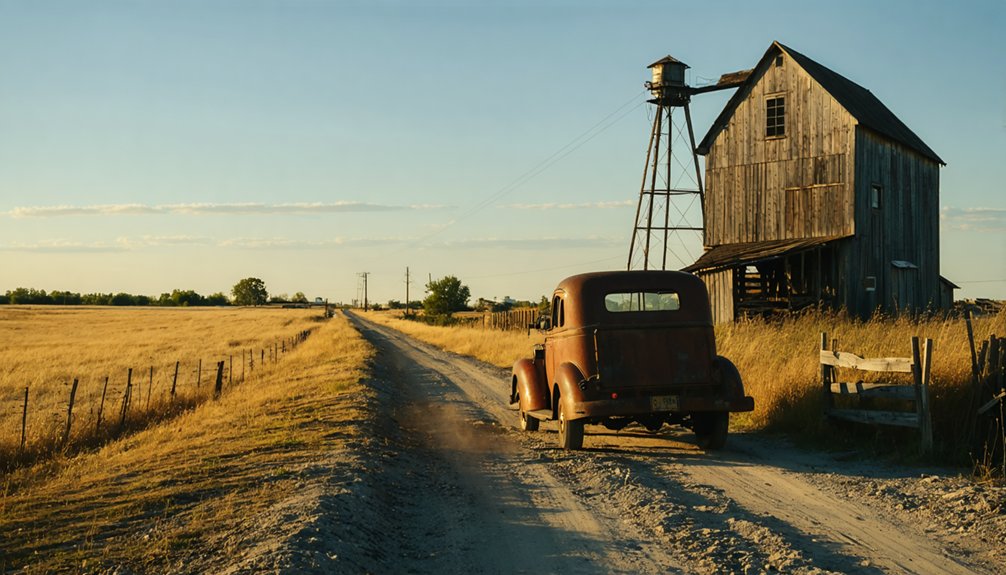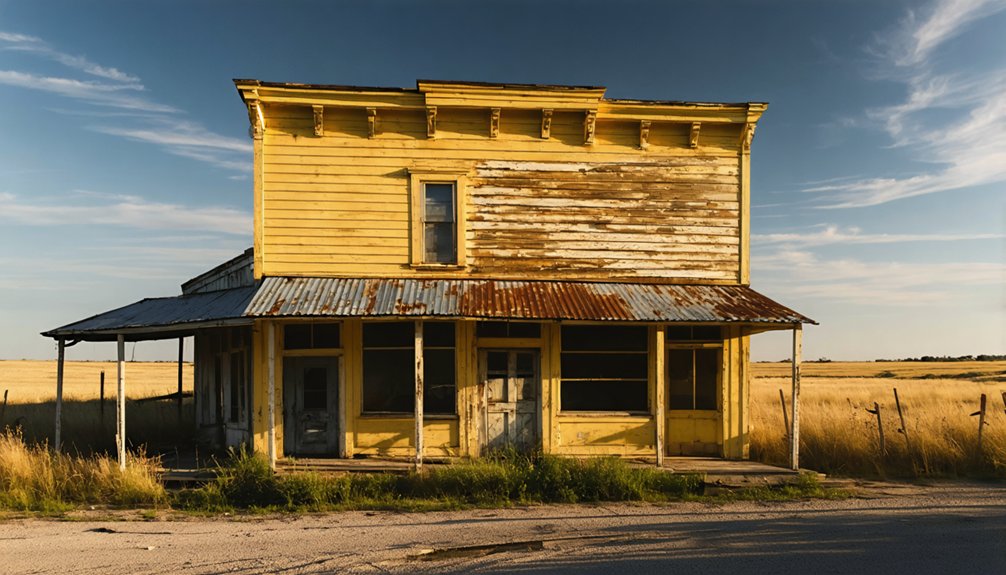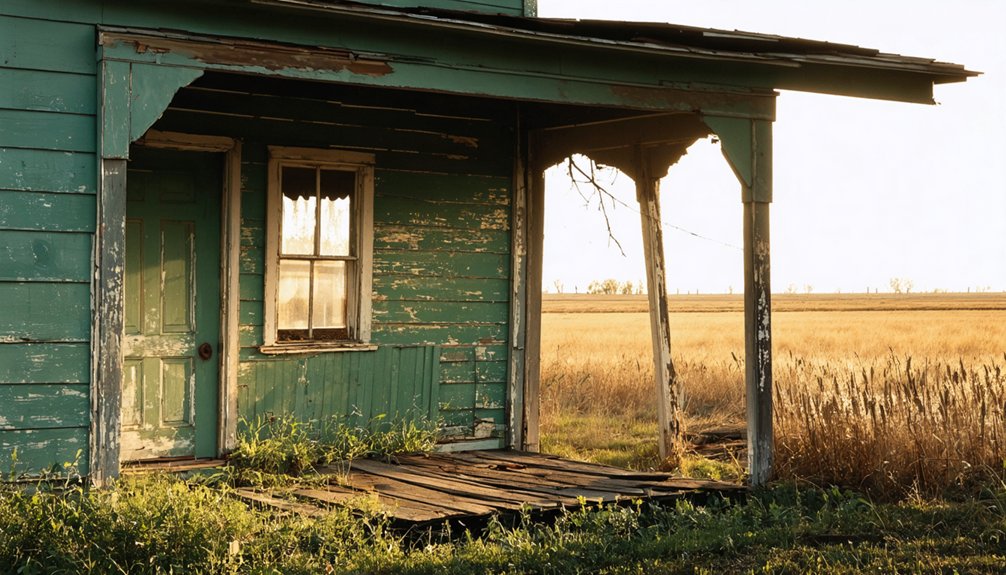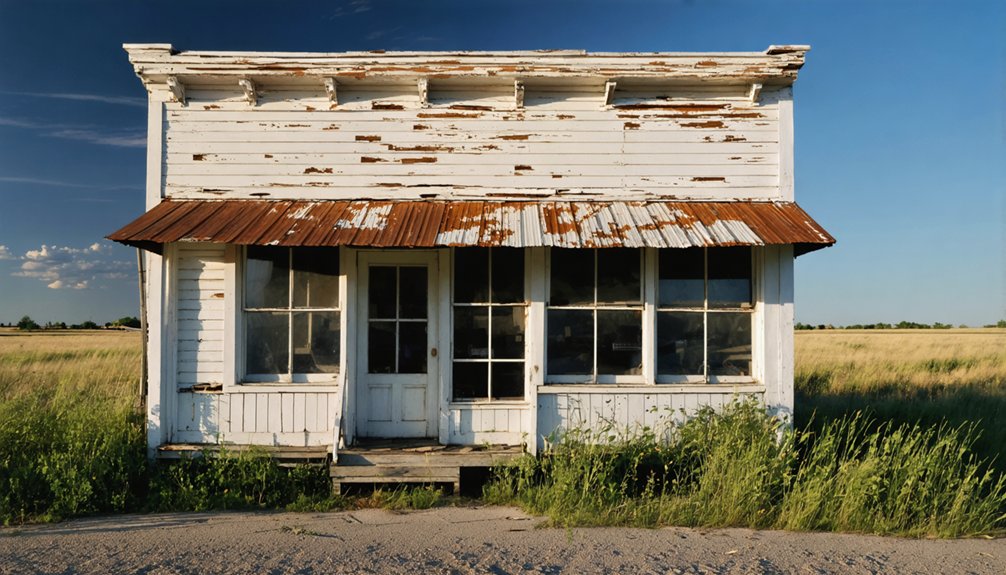You’ll find the remnants of Rossville nestled in South Dakota’s Black Hills, where fortune seekers flocked during the 1874 gold rush. This once-bustling mining town thrived with saloons, general stores, and boarding houses as the Homestake Mining Company extracted precious ore. Today, you can explore weathered wooden structures and abandoned mine sites that tell tales of dangerous underground work, vigilante justice, and harsh frontier life. The ghost town‘s crumbling walls hold countless untold stories of boom-and-bust America.
Key Takeaways
- Rossville emerged during the 1874 Black Hills Gold Rush, growing rapidly as miners defied the Fort Laramie Treaty seeking fortune.
- The town flourished with commercial establishments including general stores, saloons, and hotels serving the mining community.
- Mining operations, particularly the Homestake Mine, drove economic growth until declining ore quality and rising costs led to closures.
- Transportation networks of railroads, stagecoach lines, and military supply routes initially supported the town’s development and trade.
- Today, Rossville stands as a ghost town with abandoned buildings and deteriorating structures accessible only by gravel roads.
The Gold Rush Origins of Rossville
While the Black Hills Gold Rush of 1874 sparked the establishment of numerous mining settlements across South Dakota, Rossville emerged during this transformative period following Custer’s expedition into the region.
You’ll find that its gold discovery followed the pattern of many Black Hills settlements, where prospectors first searched creek beds for placer gold before moving on to hard-rock mining operations.
Like its neighboring towns of Deadwood and Lead, Rossville’s town establishment coincided with the region’s mining boom that transformed the Black Hills landscape. The Homestake Mining Company, established in 1877, would become the region’s dominant mining operation.
During this time, miners flocked to the area, defying the Fort Laramie Treaty of 1868 in their pursuit of riches.
The town grew alongside the development of mills and mining operations that processed both gold and silver ores. The region experienced tremendous growth as miners had claimed all creek lands by 1876.
Life in a Black Hills Mining Camp
As miners poured into Rossville’s mining camps, they encountered harsh realities of frontier life that tested their resilience daily.
Camp life meant living in crude wooden shelters or tents, battling the elements with poor insulation and limited amenities. You’d find yourself working grueling shifts in dangerous underground tunnels, facing constant threats from falling rock, toxic gases, and extreme heat. After the 1874 gold discovery in French Creek, miners rushed to establish camps like Rossville across the Black Hills. Early mining challenges often led to the eventual abandonment of these settlements, leaving remnants scattered throughout the region.
Life in mining camps tested human limits daily, with primitive shelter offering little refuge from nature’s harsh elements.
The miner community structured itself around three distinct social layers:
- Mine owners and managers who controlled operations
- Skilled laborers who earned decent wages and respect
- Unskilled workers who endured the harshest conditions
You’d spend your free time at the camp’s saloons and dance halls, where diverse immigrant groups gathered to escape the daily grind.
With minimal law enforcement, you’d rely on vigilance committees to maintain order in your isolated frontier community.
Mining Operations and Economic Growth
The economic heart of Rossville beat strongest through its mining operations, which stretched far beyond the daily toil of camp life.
Mining technology advancements transformed the landscape, as you’d have witnessed the shift from animal labor to compressed air locomotives by 1901, revolutionizing underground efficiency. Workers prioritized safety through mandatory use of helmets and lamps during all underground operations.
The Homestake Mine became America’s largest gold producer after George Hearst’s $70,000 acquisition in 1878. You’d have seen the region’s prosperity grow through Charles Merrill’s innovative cyanidization process, boosting gold recovery rates to 94%.
Despite setbacks from devastating fires in 1907 and 1919, the mines pushed deeper, with the Ross and Yates shafts reaching unprecedented depths of 6,800 feet by 1975.
However, economic sustainability challenges emerged as environmental regulations tightened and production costs rose, ultimately leading to closure in 2002 after 126 years of nearly continuous operation.
Daily Struggles of Early Settlers
If you’d lived in Rossville during its mining heyday, you’d have faced grueling physical labor alongside harsh living conditions that tested both body and spirit.
Your family’s survival would’ve hinged on adapting to primitive housing that offered little protection from Dakota Territory’s extreme weather, including bitter winters and scorching summers. Settlers had to make do with alternative fuel sources like buffalo and cow chips to stay warm, as wood was scarce and expensive. Living conditions were similar to those faced by the Manterville settlers who struggled to establish homes in the region.
The lack of proper medical care and isolation from larger settlements meant that even minor illnesses or injuries could become life-threatening ordeals for mining families.
Mining Family Hardships
Life in South Dakota’s mining settlements brought unrelenting hardships for families seeking their fortunes during the Black Hills Gold Rush. You’d find mining families facing constant uncertainty as gold deposits depleted and claims were abandoned. Their family resilience was tested through:
- Dangerous working conditions with toxic mercury exposure and treacherous mine shafts
- Makeshift housing in overcrowded tent camps and basic log shelters
- Limited access to medical care and essential supplies in remote locations
Living in these isolated communities meant you’d struggle with unstable income, while environmental hazards from mining waste threatened your family’s health. The first year yielded approximately $150,000 in gold, creating intense competition among miners desperate to stake profitable claims.
The mining legacies of these settlements reveal how families endured primitive conditions, moving frequently between camps as mines closed, all while dealing with the physical toll of intense labor in harsh mountain environments. By the winter of 1877, nearly 500 residents crowded into Rochford’s growing settlement, with many forced to live in temporary shelters.
Weather and Health Challenges
Settlers in Rossville confronted brutal weather extremes that’d test their survival skills throughout the year. You’d face winter temperatures plunging below zero, while summer highs could reach the mid-80s.
These weather impacts created a challenging environment where you’d need to constantly adapt your daily routines and farming practices.
The harsh climate brought severe health risks to your family. You’d battle respiratory illnesses from smoke-filled cabins during winter months, and frostbite was a constant threat.
When spring arrived, melting snow and rain created muddy conditions that could contaminate your water supply. During the brief growing season, you’d work intensely to plant and harvest before early frosts hit, all while protecting livestock from extreme temperatures and securing enough food to survive the long winters.
Transportation and Trade Routes

Three major transportation networks shaped Rossville’s development and eventual decline: the railroad, stagecoach lines, and military supply routes.
You’ll find Rossville’s trade routes were strategically positioned, with the railroad depot serving as the town’s lifeline for mail, passengers, and agricultural shipments. The town’s T-shaped layout maximized railroad access, while stagecoach lines connected it to regional military forts.
Key transportation routes included:
- North-south roads linking the Missouri River to the Yellowstone Basin
- East-west connections to Fort Logan and Fort Shaw
- Bull train and mule train paths connecting Fort Pierre to Deadwood
When automobiles replaced trains post-World War II, Rossville’s transportation advantages diminished. The once-bustling railroad depot became obsolete, marking a turning point in the town’s destiny.
The Glory Days of Commerce
During Rossville’s peak in the 1870s, a bustling commercial district emerged from the region’s lucrative gold discoveries, transforming the once-sparse settlement into a thriving economic hub.
You’d find a remarkable commercial diversity along its streets, where general stores, saloons, and mining supply shops competed for the attention of miners and settlers. Local entrepreneurs established hotels and boarding houses to accommodate the constant flow of fortune seekers, while medical services and religious institutions supported the growing community.
The town’s economic resilience was strengthened by crucial infrastructure, including a post office and stage station that facilitated essential communication and trade.
Business owners capitalized on the mining boom, with property lots selling for $10 to $60, allowing merchants to quickly establish themselves in this promising frontier marketplace.
From Boom to Abandonment

When the mining activities finally wound down in Rossville, you’d have seen a rapid exodus of workers and their families seeking opportunities elsewhere.
You can still spot the empty storefronts and abandoned homes that tell the story of Rossville’s decline from a bustling mining town to a quiet ghost town.
The buildings now stand as silent sentinels of the past, with their weathered walls and broken windows bearing witness to the town’s dramatic transformation from boom to bust.
Mining Activities End
As the quality of ore steadily declined in Rossville’s mines throughout the early 1900s, mining operations faced mounting challenges that would ultimately lead to their demise.
The mining decline accelerated due to several critical factors that made operations increasingly unprofitable, despite technological advances like cyanidization and compressed air locomotives.
The economic impacts became particularly severe due to:
- Depletion of high-grade ore requiring costly hard rock processing methods
- Labor shortages during World War II, compounded by the L-208 order halting production
- Rising production costs that couldn’t be offset by the lower-quality refractory gold ore
You’ll find that by mid-20th century, most mining operations in Rossville had ceased entirely, leaving behind abandoned shafts and contributing to the area’s transformation into a ghost town.
Population Rapidly Declines
The steady decline of Rossville’s mining operations triggered a dramatic population exodus that would transform this once-bustling town into a shell of its former self.
You’ll find that the population decline followed patterns typical of rural South Dakota communities, with younger residents leaving first for education and jobs in urban areas, followed by older adults seeking better healthcare access.
The town’s demographic shifts accelerated as household sizes shrank and deaths began to outpace births.
Without economic diversification to retain its workforce, Rossville couldn’t escape the rural migration trend that affected many similar communities.
Limited infrastructure and dwindling social amenities made it increasingly difficult to attract new residents.
Buildings Stand Empty
Today’s visitors to Rossville encounter a haunting collection of deteriorating structures that tell stories of the town’s former prosperity.
You’ll find abandoned architecture ranging from commercial storefronts to residential homes, all succumbing to the relentless decay consequences of Black Hills weather and neglect.
The town’s buildings reveal their decline through:
- Collapsed roofs exposing interior rooms to harsh elements
- Original wood siding and stone foundations slowly eroding away
- Vandalized walls covered in graffiti and stripped of salvageable materials
Once-thriving businesses stand frozen in time, their empty shells a reflection of Rossville’s economic downfall.
Without maintenance or investment, these historic structures continue deteriorating as nature reclaims the land.
Vegetation creeps up walls, wildlife makes homes in abandoned rooms, and the harsh Dakota climate hastens their inevitable collapse.
Exploring the Ghost Town Today

Visitors exploring Rossville’s haunting remains will find a remote ghost town accessible only by gravel or dirt roads, requiring suitable vehicles for the journey.
You’ll need to navigate carefully through the site, as there’s no formal guidance or maintained paths. When practicing ghost town etiquette, stay clear of unstable structures and respect any private property boundaries you encounter.
For the best photography tips, arrive during morning or late afternoon hours when shadows create dramatic contrasts among the weathered ruins and foundations.
You’ll want to document the authentic mining-era architecture and scattered remnants that tell Rossville’s story. Since there aren’t any interpretive signs or visitor services, it’s wise to research the town’s history beforehand and bring necessary supplies for exploring remote terrain.
Preserving Rossville’s Mining Heritage
Beyond exploring Rossville’s physical remains, dedicated efforts preserve its rich mining heritage through extensive documentation and conservation initiatives.
Through heritage conservation programs, you’ll find carefully preserved artifacts, machinery, and structures that tell the story of early 20th-century mining innovation.
Step back in time as preserved mining artifacts and machinery reveal pioneering industrial advances that shaped early 1900s extraction methods.
Archival preservation efforts have documented Rossville’s mining evolution through:
- Historical maps and geologist reports detailing shaft depths
- Photographic collections showcasing gold milling technologies
- Oral histories from miners’ descendants capturing daily life
You can experience this history through interpretive signage, rotating museum exhibits, and annual heritage days celebrations.
Local heritage groups actively engage the community through educational programs and volunteer opportunities, while state regulations guarantee these historic sites remain protected.
Environmental remediation works alongside preservation efforts to maintain both the site’s historical integrity and public safety.
Frequently Asked Questions
Were There Any Notable Crimes or Lawlessness Reported in Rossville?
Like shadows in forgotten mines, you won’t find substantial crime history or law enforcement records from this place. While nearby towns had documented lawlessness, no notable criminal activity’s been specifically tied here.
What Native American Tribes Originally Inhabited the Rossville Area?
You’ll find that Lakota and Dakota Sioux were the primary inhabitants, bringing their rich Sioux culture and tribal traditions to the area after displacing earlier Paleo-Indian hunter-gatherers around 10,000 years ago.
Did Any Famous Historical Figures Ever Visit or Stay in Rossville?
You won’t find records of any famous visitors making their mark in Rossville. While notable figures frequented larger Black Hills towns during historical events, this small mining camp didn’t attract documented celebrity guests.
What Was the Average Life Expectancy of Rossville Residents During Mining Days?
Like a flickering candle, you’d have lived just 40-50 years during mining days. Poor mining health conditions, toxic exposures, and lack of medical care drastically shortened life expectancy.
Were There Any Significant Natural Disasters That Affected Rossville?
You won’t find records of major natural disasters affecting this settlement – no documented flood damage or drought impact appears in historical archives of the Black Hills mining community.
References
- https://www.legendsofamerica.com/rochford-south-dakota/
- https://www.powderhouselodge.com/black-hills-attractions/fun-attractions/ghost-towns-of-western-south-dakota/
- https://www.sdpb.org/rural-life-and-history/2023-08-21/some-black-hills-ghost-towns-and-their-origins
- https://www.sdhspress.com/journal/south-dakota-history-2-2/some-black-hills-ghost-towns-and-their-origins/vol-02-no-2-some-black-hills-ghost-towns-and-their-origins.pdf
- https://www.southdakotamagazine.com/watson-parker-ghost-town-friends
- https://www.youtube.com/watch?v=_0WNYsFLSLA
- https://en.wikipedia.org/wiki/List_of_ghost_towns_in_South_Dakota
- https://www.blackhillshikingbikingandmore.com/old-mining-ghost-towns
- https://en.wikipedia.org/wiki/Black_Hills_gold_rush
- https://westernmininghistory.com/library/186/page1/



